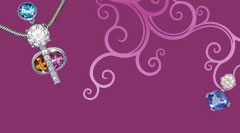Victorian Influences in Indian Jewellery Design
Labels:
Cannatille,
characteristics,
design elements,
Filigree,
Repousse,
Victorian Jewellery,
Victorian-Style Indian Jewellery
The Victorian influence in India can be traced back to 1876 when Queen Victoria was crowned Empress of India (1876), thereby encouraging trade between the two continents.
The Indian exotic woods, bright-coloured silks, enamelled and gem encrusted Mughul jewellery, had a profound effect on the jewellery and decorative arts produced in England then. The Indian rose-cut garnet encrusted jewels and cloisonné enamels worked their way into English design. Likewise, Indian jewellery designs too borrowed from the Victorian.
Infact, even today, long after India got its independence, the inimitable touch of the Victorian can be found in the Indian Jewellery Industry. Both the exclusive designers & the big jewellery design houses in India, have been churning out Victorian jewellery collections year after relentless year. But, what the buyer gets is sometimes far from the traditional Victorian fare and can only be labelled ' Victorian-Style INDIAN' jewellery. The delicate and curvy Victorian motifs combined with Indian motifs are very popular in wedding and festive diamond jewellery today.

Listed below are a few design elements that are characteristic of the jewellery of the Victorian era (1837-1901):
1) Jewellery was mostly made in18 to 22 karat gold & whenever diamonds were to be set, they were invariably white metal would be used to enhance their intrinsic beauty.
2) Natural elements like flowers, trees, and birds were predominant in the design. Commonly used motifs were serpents (a symbol of eternity), love and song birds, love knots, clasped hands and miniatures.
3) Two of the most popular design techniques were 'CANNATILLE' and 'REPOUSSE'. Cannatille jewellery used twisted strands of gold wire wound into elaborate designs giving it a delicate look, while Repousse typically had solid forms with raised and fluted edges.
4) Besides Cannatille and Repousse, the other techniques used were 'Filigree', Die rolling and Engraving which gave the illusion of mass and size, while only using a minimum amount of precious metal.
5) The jewellery was often accented with seed pearls, turquoise and pink coral. Other gemstones used include blue zircon, "pinked" or heat treated topaz, amethyst, peridot, citrine, aquamarine, garnet, ruby, sapphire and emerald.
6) Natural materials such as tortoise shell, lava, ivory and vulcanite too were popular choices, especially for carved pieces, miniatures and cameos.
1) Jewellery was mostly made in18 to 22 karat gold & whenever diamonds were to be set, they were invariably white metal would be used to enhance their intrinsic beauty.
2) Natural elements like flowers, trees, and birds were predominant in the design. Commonly used motifs were serpents (a symbol of eternity), love and song birds, love knots, clasped hands and miniatures.
3) Two of the most popular design techniques were 'CANNATILLE' and 'REPOUSSE'. Cannatille jewellery used twisted strands of gold wire wound into elaborate designs giving it a delicate look, while Repousse typically had solid forms with raised and fluted edges.
4) Besides Cannatille and Repousse, the other techniques used were 'Filigree', Die rolling and Engraving which gave the illusion of mass and size, while only using a minimum amount of precious metal.
5) The jewellery was often accented with seed pearls, turquoise and pink coral. Other gemstones used include blue zircon, "pinked" or heat treated topaz, amethyst, peridot, citrine, aquamarine, garnet, ruby, sapphire and emerald.
6) Natural materials such as tortoise shell, lava, ivory and vulcanite too were popular choices, especially for carved pieces, miniatures and cameos.
See pictures of Victorian Jewellery here
You can pick a piece of precious history this Diwali, a Victorian style necklace or earrings maybe!


No comments:
Post a Comment